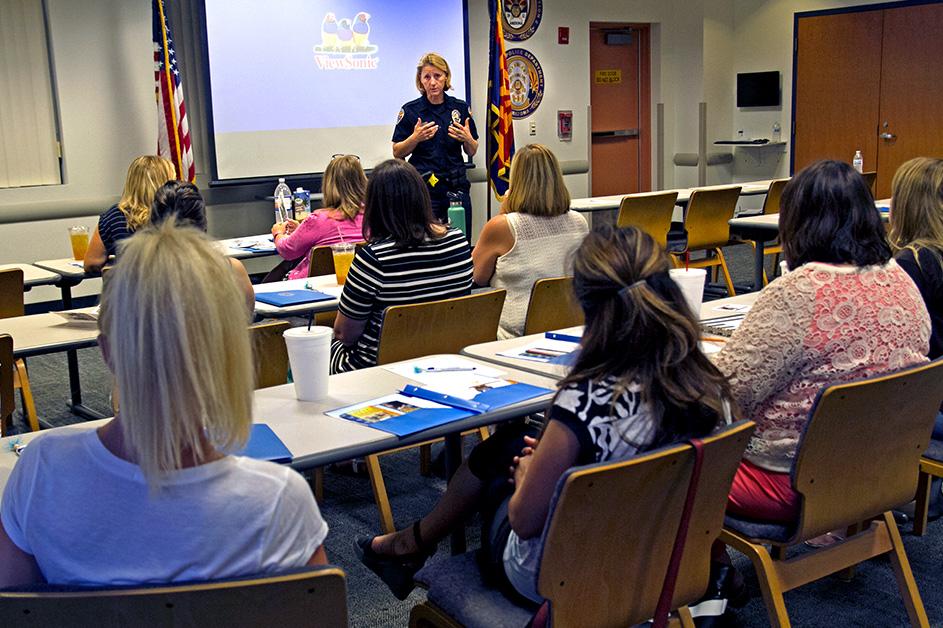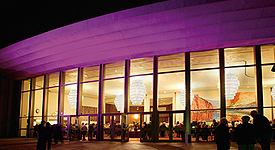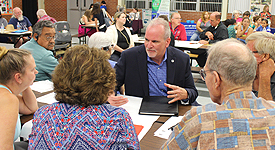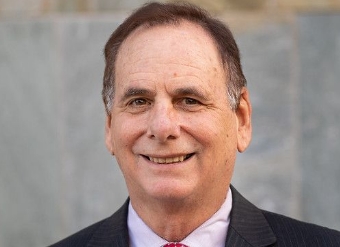
Crime prevention and crime control efforts are often at odds with each other, especially if crime control focuses solely on enforcement. Connections between preventing and controlling crime, however, can be made if residents, teachers, parents, businesses, and the overall community are linked to police through networking, trust building, investment in the community, awareness, and communication. The Chandler, Arizona, Police Department has found an effective way to integrate crime prevention and crime control through its Guardian Academy.
When Theory and Practice Collide
People can discourage crime by being in a particular place at a particular time. A parent becomes an “intimate handler” because he or she has knowledge of his child’s “bad” behavior and thus serves as a mechanism for informal social control.1 A teacher becomes a “capable guardian” when he or she recognizes someone loitering in the school building and brings the person to the attention of security.2 Instead of the police having to continuously exert their legal authority, having people handle these minor problems eases that responsibility and reduces crime, freeing the police up for other crime-fighting efforts.3 The criminological theory of collective efficacy speaks to the way in which crime prevention and crime control come together.
“Collective efficacy” refers to the degree to which people trust their neighbors to provide a sense of safety and to intervene if something problematic happens. Intervening can include things like calling the police; asking questions of strangers; notifying parents if their children are misbehaving; forming community groups to address problems; or, at a higher level, attending city council meetings to request assistance from city or county government. Research shows that neighborhoods with higher collective efficacy experience lower rates of violent crime.4
The implementation of collective efficacy can help police departments develop community-based crime control. The Bureau of Justice Assistance (BJA), through its Community-Based Crime Reduction Program and Strategies for Police Innovation Program, has supported efforts to implement collective efficacy. For example, in Austin, Texas; Brooklyn Park, Minnesota; Los Angeles, California; Miami-Dade County, Florida; and Nashville, Tennessee, BJA has funded the police, community-based organizations, and county governments to engage in building trust, strengthening neighborhood networks, and controlling crime. These principles form the backbone of collective efficacy and are effected through officers meeting with and talking to people one-to-one, introducing residents to their neighbors, and helping to create bonds among people who might not have met or talked to one another. These activities take time, energy, commitment, and investment in neighborhoods, organizations, and communities. Ultimately, these practices lead to safer neighborhoods and give people confidence in their abilities to make good decisions.
The Guardian Academy

The Chandler Police Department (CPD) found an innovative way to implement collective efficacy and, thus, prevent crime. The impetus for the Guardian Academy (the Academy) came from the community when a parent requested a class on street drugs to help parents be more aware of what their children are facing every day. The parent already trusted the Chandler Police Department, as demonstrated by the request, and the action of creating the Academy further strengthened that relationship. The idea for a class evolved into a full curriculum and into its current offering and purpose: “The Academy provides education, information, and access to resources that promote and reinforce healthy relationships and communication within families.” Two goals were articulated: The Academy will (1) inform, share, enlighten, and educate participants about the warning signs of criminal or risky adolescent behavior and (2) proactively establish positive and healthy relationships between the police and guardians. These goals are accomplished by:
- increasing situational awareness among guardians;
- encouraging and empowering participants to have hard and heartfelt conversations about sensitive and high-risk topics with children;
- providing a safe platform for open dialogue and facilitating conversations by providing communication tools; and
- encouraging active involvement of a guardian in a child’s life.
Since 2017, about 250 community members have graduated from the Academy, and the seventh cohort began in September 2019. The first Academy included about 30 participants, and because of its increased reputation and acceptance, the class is now limited to 50. Because of its popularity among teachers and educators, two schools have requested their own Academy class that would include faculty members and student guardians.
Guardian Academy Overview
The Guardian Academy is a five-week, 15-hour program composed of a weekly class that begins at 6 p.m. and ends at 9 p.m. Core topics for the Guardian Academy include social media, drug trends, gangs, human trafficking, mental health, risky and criminal activity, and cyberbullying. Courses are taught by subject matter experts. Further, the courses are interactive; discussions are encouraged as participants have questions and interests in talking about different topics. Each course is designed to create awareness and provide authority-based knowledge.

Participants are provided with the following resources:
- A tailored course manual, including a resource section to connect participants to outside resources in the community
- Direct and in-person access to outside resources and networking to streamline resources
- Actionable steps to implement information received in the class
- Active tools for guardians to exhibit digital leadership of their child’s media presence and electronics
- Access to a private, member-only Facebook page for Guardian Academy graduates
Guardian Academy Costs
CPD underwrites the costs of the Academy. The agency’s crime prevention officer provides logistical and administrative support through scheduling courses, lining up faculty from the department and the community, putting together appropriate course materials, advertising, maintaining the list of participants, and communicating with them. In addition, CPD also provided continuing education credit hours for teachers and graduation certificates for those who completed the program with 100 percent attendance.
Each five-week cohort costs the agency about $250 for food and course material printing. Individual sessions are taught by credentialed and experienced subject matter experts who volunteer their time and knowledge. These instructors make the Academy a highly cost-effective program.
Reaching Parents, Teachers and Participants
The success of the Academy is demonstrated, not just in its popularity among Chandler and surrounding communities, but also through the evaluations and anecdotes of the participants. Many participants have voiced their praise and approval of the content of the Academy, but more importantly, they express the
changes that have occurred in their own behaviors or those of their offspring or students.
For example, one Academy graduate wrote:

The Academy gave me more confidence to feel like an "expert" about the importance of making sure of own children are protected from some of the harms of social media. In the past, I might have made vague objections [to social media], but what I “knew” had no authority. With the backing of the Academy, I feel the power of that borrowed authority. I’m able to say, “No, my children will not install that app.”
Another graduate wrote about the specific changes they made in their household following the Academy:
First, we did a contract for my son’s cellphone use… and have enforced consequences. We have family discussions about why we are so strict about the usage and apps, review what is on his phone, and monitor his usage. We have a “no-cellphone” policy after 8 p.m.; it is also a house rule that the phone goes in our room for the evening, and we spend family time together playing board games and hanging out. Attending this Academy has made me more aware of the enticements and dangers that are in the cyberworld and made me realize that the danger is ever-changing. Even though it is a lot of work, I know we must be on top of it.
Importantly, the parent added, “I also try to share what I have learned to others… it has been mostly well received.” This is an example of how informal social control works, not only among a family, but through the use of networking and communication to spread the word about how to handle issues that are
important to neighbors.
A guidance counselor and parent echoed these sentiments, by saying,
For my oldest, who is 4, we definitely set a screen-time limit, and I interact with her more while she's using the iPad and make sure I watch what she's watching, too. However, as a guidance counselor, I know more of what I should be looking and listening for when students come to report incidents and what to inform families of.
These unsolicited comments show the way in which the Academy is able to bring about change in the way people think and act when it comes to guarding their own families and, by extension, their friends and colleagues.
Guardian Academy Outcomes
The CPD has a high level of trust with its community, and the Guardian Academy continues that tradition. As a result of the first six Guardian Academy cohorts, word has spread throughout and beyond teachers in the school districts to parent-teacher associations, neighborhood groups, churches, crime analysis organizations, and law enforcement agencies across the globe. Demand for the Guardian Academy classes
has increased, and more than 50 applicants per class is the norm.
Chandler crime prevention officers now receive proactive calls from schools, parents, and other guardians to address concerns that, if left unanswered, could lead to or become crimes. The willingness to call the police is a strong indicator of the effectiveness of the message given in the Academy and demonstrates that people are willing to intervene—a major tenet of collective efficacy.
Further, CPD has found that improvements have occurred outside of the classroom and have made inroads into the community.
Increased Education and Awareness: The Guardian Academy both educates and makes people aware of issues. People don’t know what they don’t know until they get real information from experts who assist them in processing the information.
Enhanced Networking and Resourcing: The Academy provides a safe place where people can talk, share similar experiences and situations, and obtain resources to deal with problems or potential problems.
Increased Relationship Building: By bringing people together, the Academy facilitates building trust among people—relationships are built not only between participants and the police, but also among teachers, residents, community members, leaders, stakeholders, and experts. These relationships extend beyond the Academy and bring a better understanding of safety to the community.
Notes:
1 Marcus Felson, “Those Who Discourage Crime,” in Crime and Place: Crime Prevention Studies, eds. John E. Eck and David Weisburd (Newark, NJ: Willow Tree Press, 1995), 53–66.
2 Ronald V. Clark, Situational Crime Prevention: Successful Case Studies (Albany, NY: Harrow and Heston, 1992).
3 Craig D. Uchida et al., Community, Crime Control, and Collective Efficacy: Neighborhoods and Crime in Miami (Lanham, MD: Lexington Books, 2015).
4 Robert J. Sampson et al., “Neighborhoods and Violent Crime: A Multilevel Study of Collective Efficacy,” Science 277 (1997): 918–924.
5 Comments are from the Guardian Academy Alumni Facebook page (2016–2019).
For more information about the Guardian Academy, contact Officer Noah Dueker.
This article was featured in the October 2019 edition of Police Chief Magazine. The Police Chief is the official publication of the International Association of Chiefs of Police.



